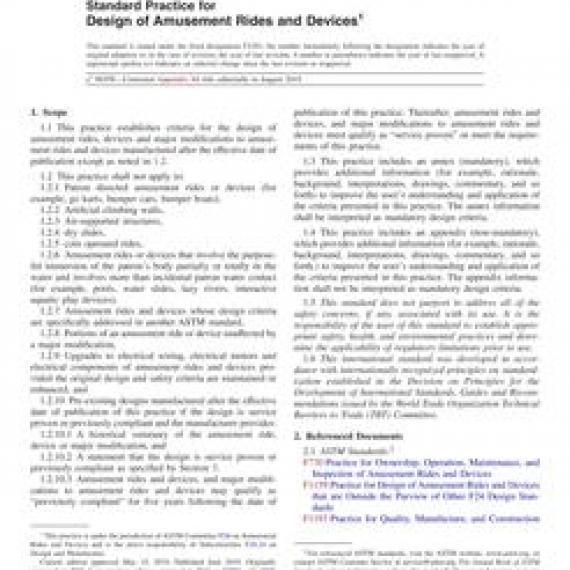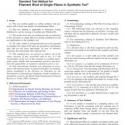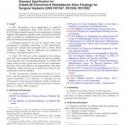No products
ASTM F2291-19e1
ASTM F2291-19e1 Standard Practice for Design of Amusement Rides and Devices
standard by ASTM International, 05/15/2019
Full Description
1.1This practice establishes criteria for the design of amusement rides, devices and major modifications to amusement rides and devices manufactured after the effective date of publication except as noted in 1.2.
1.2This practice shall not apply to:
1.2.1Patron directed amusement rides or devices (for example, go karts, bumper cars, bumper boats),
1.2.2Artificial climbing walls,
1.2.3Air-supported structures,
1.2.4dry slides,
1.2.5coin operated rides,
1.2.6Amusement rides or devices that involve the purposeful immersion of the patron's body partially or totally in the water and involves more than incidental patron water contact (for example, pools, water slides, lazy rivers, interactive aquatic play devices),
1.2.7Amusement rides and devices whose design criteria are specifically addressed in another ASTM standard,
1.2.8Portions of an amusement ride or device unaffected by a major modification,
1.2.9Upgrades to electrical wiring, electrical motors and electrical components of amusement rides and devices provided the original design and safety criteria are maintained or enhanced, and
1.2.10Pre-existing designs manufactured after the effective date of publication of this practice if the design is service proven or previously compliant and the manufacturer provides:
1.2.10.1A historical summary of the amusement ride, device or major modification, and
1.2.10.2A statement that the design is service proven or previously compliant as specified by Section 3.
1.2.10.3Amusement rides and devices, and major modifications to amusement rides and devices may qualify as previously compliant for five years following the date of publication of this practice. Thereafter, amusement rides and devices, and major modifications to amusement rides and devices must qualify as service proven or meet the requirements of this practice.
1.3This practice includes an annex (mandatory), which provides additional information (for example, rationale, background, interpretations, drawings, commentary, and so forth) to improve the user's understanding and application of the criteria presented in this practice. The annex information shall be interpreted as mandatory design criteria.
1.4This practice includes an appendix (non-mandatory), which provides additional information (for example, rationale, background, interpretations, drawings, commentary, and so forth.) to improve the user's understanding and application of the criteria presented in this practice. The appendix information shall not be interpreted as mandatory design criteria.
1.5This standard does not purport to address all of the safety concerns, if any, associated with its use. It is the responsibility of the user of this standard to establish appropriate safety, health, and environmental practices and determine the applicability of regulatory limitations prior to use.
1.6This international standard was developed in accordance with internationally recognized principles on standardization established in the Decision on Principles for the Development of International Standards, Guides and Recommendations issued by the World Trade Organization Technical Barriers to Trade (TBT) Committee.


































